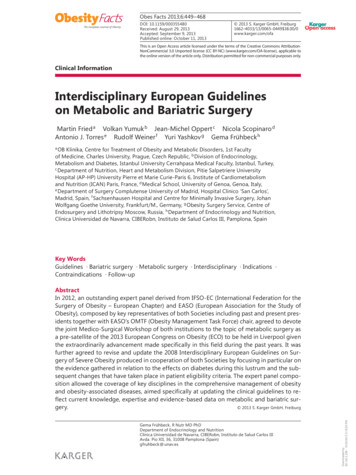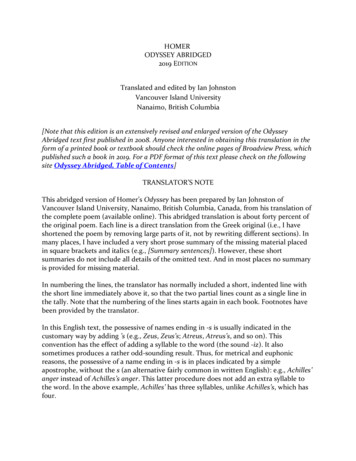
Transcription
Obes Facts 2013;6:449–468DOI: 10.1159/000355480Received: August 29, 2013Accepted: September 9, 2013Published online: October 11, 2013 2013 S. Karger GmbH, Freiburg1662–4033/13/0065–0449 38.00/0www.karger.com/ofaThis is an Open Access article licensed under the terms of the Creative Commons AttributionNonCommercial 3.0 Unported license (CC BY-NC) (www.karger.com/OA-license), applicable tothe online version of the article only. Distribution permitted for non-commercial purposes only.Clinical InformationInterdisciplinary European Guidelineson Metabolic and Bariatric SurgeryMartin Fried a Volkan Yumuk b Jean-Michel Oppert c Nicola Scopinaro dAntonio J. Torres e Rudolf Weiner f Yuri Yashkov g Gema Frühbeck ha OBKlinika, Centre for Treatment of Obesity and Metabolic Disorders, 1st Facultyof Medicine, Charles University, Prague, Czech Republic, b Division of Endocrinology,Metabolism and Diabetes, Istanbul University Cerrahpasa Medical Faculty, Istanbul, Turkey,cDepartment of Nutrition, Heart and Metabolism Division, Pitie Salpetriere UniversityHospital (AP-HP) University Pierre et Marie Curie-Paris 6, Institute of Cardiometabolismand Nutrition (ICAN) Paris, France, d Medical School, University of Genoa, Genoa, Italy,eDepartment of Surgery Complutense University of Madrid, Hospital Clinico ‘San Carlos’,Madrid, Spain, f Sachsenhausen Hospital and Centre for Minimally Invasive Surgery, JohanWolfgang Goethe University, Frankfurt/M., Germany, g Obesity Surgery Service, Centre ofEndosurgery and Lithotripsy Moscow, Russia, h Department of Endocrinology and Nutrition,Clínica Universidad de Navarra, CIBERobn, Instituto de Salud Carlos III, Pamplona, SpainKey WordsGuidelines · Bariatric surgery · Metabolic surgery · Interdisciplinary · Indications ·Contraindications · Follow-upGema Frühbeck, R Nutr MD PhDDepartment of Endocrinology and NutritionClínica Universidad de Navarra, CIBERobn, Instituto de Salud Carlos IIIAvda. Pio XII, 36, 31008 Pamplona (Spain)gfruhbeck @ unav.esDownloaded by:90.152.2.236 - 10/25/2013 3:16:22 PMAbstractIn 2012, an outstanding expert panel derived from IFSO-EC (International Federation for theSurgery of Obesity – European Chapter) and EASO (European Association for the Study ofObesity), composed by key representatives of both Societies including past and present presidents together with EASO’s OMTF (Obesity Management Task Force) chair, agreed to devotethe joint Medico-Surgical Workshop of both institutions to the topic of metabolic surgery asa pre-satellite of the 2013 European Congress on Obesity (ECO) to be held in Liverpool giventhe extraordinarily advancement made specifically in this field during the past years. It wasfurther agreed to revise and update the 2008 Interdisciplinary European Guidelines on Surgery of Severe Obesity produced in cooperation of both Societies by focusing in particular onthe evidence gathered in relation to the effects on diabetes during this lustrum and the subsequent changes that have taken place in patient eligibility criteria. The expert panel composition allowed the coverage of key disciplines in the comprehensive management of obesityand obesity-associated diseases, aimed specifically at updating the clinical guidelines to reflect current knowledge, expertise and evidence-based data on metabolic and bariatric sur 2013 S. Karger GmbH, Freiburggery.
450Obes Facts 2013;6:449–468DOI: 10.1159/000355480 2013 S. Karger GmbH, Freiburgwww.karger.com/ofaFried et al.: Interdisciplinary European Guidelines on Metabolic and Bariatric SurgeryThe term ‘globesity’ describes the world-wide epidemic that currently affects bothdeveloped and developing countries [1–3]. In 2008, according to the World Health Organization (WHO), 1.4 billion adults, 20 years of age and older, were overweight with an estimated500 million adults world-wide being obese (over 200 million men and nearly 300 millionwomen) [2–4]. In 2009–2010 in the USA the age-adjusted prevalence of obesity was 35.5%among adult men and 35.8% among adult women [5] with the prevalence of obesity inchildren and adolescents being 16.9% [6]. Noteworthy, the prevalence of obesity has tripledsince the 1980s in many countries of the WHO European Region with overweight and obesityaffecting 50% of the population in the majority of European countries [2–4]. It has been estimated that 60% of the world’s population, i.e., 3.3 billion people, could be overweight (2.2billion) or obese (1.1 billion) by 2030 if recent trends continue [7].In spite of excess weight being considered the fifth leading risk for world-wide deathsaccording to the WHO, it has not been possible to successfully curb the obesity epidemic withmore than 40 million children under the age of 5 being overweight in 2010 [3]. Moreover,severe obesity (i.e., a BMI 35 kg/m2) represents a quickly growing segment of the epidemicin which the negative effects on health and disability are especially marked. In addition,obesity not only disproportionately affects the disadvantaged segments of the population, butthese groups experience the most relevant increases in obesity prevalence. In the USA individuals with a BMI 35 kg/m2 represent 15% of the adult population [5]. Excess weight drastically elevates a person’s risk of developing a number of non-communicable diseases, likediabetes, hypertension, stroke, dyslipidaemia, sleep apnoea, cancer, non-alcoholic steatohepatitis and other serious co-morbidities. The WHO emphasizes that 44% of the type 2 diabetesmellitus (T2DM) burden, 23% of the ischaemic heart disease burden and around 7–41% ofcertain cancer burdens are attributable to overweight and obesity [3, 4]. In the majority ofEuropean countries, overweight and obesity are responsible for about 80% of cases of T2DM,35% of ischaemic heart disease and 55% of hypertensive disease among adults [4]. In addition,a range of debilitating conditions such as osteoarthritis, respiratory difficulties, gallbladderdisease, infertility and psychosocial problems, which lead to reduced life expectancy, qualityof life and disability, are extremely costly in terms of both absence from work and use ofhealth resources [2, 4, 8, 9]. Noteworthy, the lifespan of severely obese individuals is decreasedby an estimated 5–20 years depending on gender, age and race [10].At present, approximately 65% of the world’s population inhabits countries where overweight and obesity kill more people than underweight [2–4]. The WHO highlights that obesityis responsible for 10–13% of deaths in different parts of the world [2–4]. A systematic analysiswith pooled data from 19 prospective studies adjusted for age, study, physical activity, alcoholconsumption, education and marital status, comprising 1.46 million white adults and over160,000 deaths, showed that overall, for men and women combined, for every 5-unit increasein BMI, a 31% increase in risk of death was observed [11]. A recent meta-analysis focusing onall-cause mortality with the inclusion of nearly 3 million people (and encompassing 270,000deaths) reported that, relative to normal weight, both all grades of obesity (i.e., a BMI 30kg/m2) and grades 2 and 3 obesity (i.e., a BMI 35–40 kg/m2 and 40 kg/m2, respectively)were associated with significantly higher all-cause mortality [12].Bariatric surgery has proven to be the most effective mode of treatment of the morbidlyobese patients, with recent long-term studies providing evidence of a substantial reductionof mortality in bariatric surgery patients as well as decreased risk of developing new healthrelated co-morbidities, together with decreased health care utilization and drop in directhealth care costs [10, 13].Downloaded by:90.152.2.236 - 10/25/2013 3:16:22 PMIntroduction
451Obes Facts 2013;6:449–468DOI: 10.1159/000355480 2013 S. Karger GmbH, Freiburgwww.karger.com/ofaFried et al.: Interdisciplinary European Guidelines on Metabolic and Bariatric SurgeryBariatric surgery is an established and integral part of the comprehensive managementof morbidly obese patients. These guidelines were created through the interdisciplinaryeffort of key opinion leaders from international medical and surgical societies (InternationalFederation for the Surgery of Obesity (IFSO), International Federation for the Surgery ofObesity – European Chapter (IFSO-EC), European Association for the Study of Obesity (EASO))[14]. The aim of the guidelines is to provide physicians, health care practitioners, health carepolicy makers and health care providers and insurance companies with essential elements ofgood clinical practice in the treatment of obesity.Scientific evidence level data to support conclusions of this panel of experts were systematically obtained from databases such as Medline (PubMed) and the Cochrane Library.Searches spanned from January 1980 to May 2013 and were carried out with the help ofan expert in library science, together with a clinical expert with experience in systematicreviews.The key search words were obesity, obesity surgery, morbid obesity, surgical treatment,bariatric surgery, morbid obesity surgery, gastroplasty, gastric bypass, gastric plication,intestinal bypass, Roux-en-Y, gastric banding, biliopancreatic diversion, duodenal switch,biliopancreatic bypass, obesity/morbid obesity treatment outcomes, obesity/morbid obesityfollow-up, obesity/morbid obesity complications, nutrition, psychology. Some of the evidencelevel data was also retrieved from the following publications: Commonwealth of Massachusetts Betsy Lehman Center for Patient Safety and Medical Error Reduction Expert Panel onWeight Loss Surgery [15], Obesity Surgery Evidence-Based Guidelines of the European Association for Endoscopic Surgery (EAES) [16], Maggard et al.’s Meta-Analysis: Surgical Treatmentof Obesity [17] and Laville et al.’s Recommendations Regarding Obesity Surgery [18], and theClinical Practice Guidelines for the Perioperative Nutritional, Metabolic, and NonsurgicalSupport of the Bariatric Surgery Patient – 2013 Update by Mechanick et al. [19].The recommendations of the panel are supported by the best available evidence, whichincludes all evidence levels (randomized controlled trials (RCTs), systematic reviews ofcohort studies, observational outcomes studies and expert opinion). To grade the quality ofevidence, the panel adopted ‘Oxford Centre for Evidence-Based Medicine classification systembased on levels of evidence and ‘grades of recommendations according to the study designsand critical appraisal of prevention, diagnosis, prognosis, therapy and harm studies.The Oxford classification system has four evidence levels (EL):– Level A: consistent RCT, cohort study, all or none, clinical decision rule validated indifferent populations.– Level B: consistent retrospective cohort, exploratory cohort, ecological study, outcomesresearch, case-control study; or extrapolations from level A studies.– Level C: case-series study or extrapolations from level B studies.– Level D: expert opinion without explicit critical appraisal, or based on physiology, benchresearch or first experience/principles case reports.Patients in age groups from 18 to 60 years:1. With BMI 40 kg/m2 (EL A, B, C [14, 19–38]).2. With BMI 35–40 kg/m2 with co-morbidities in which surgically induced weight loss isexpected to improve the disorder (such as metabolic disorders, cardiorespiratorydisease, severe joint disease, obesity-related severe psychological problems) (EL A, B,D [39–44]).Downloaded by:90.152.2.236 - 10/25/2013 3:16:22 PMIndications for Bariatric Surgery
452Obes Facts 2013;6:449–468DOI: 10.1159/000355480 2013 S. Karger GmbH, Freiburgwww.karger.com/ofaFried et al.: Interdisciplinary European Guidelines on Metabolic and Bariatric Surgery3. BMI criterion may be the current BMI or previously maximum attained BMI of thisseverity. Note that:a) Weight loss as a result of intensified treatment before surgery (patients who reacha body weight below the required BMI for surgery) is not a contraindication forthe planned bariatric surgery.b) Bariatric surgery is indicated in patients who exhibited a substantial weight lossin a conservative treatment programme but started to gain weight again, even ifthe required minimum indication weight for surgery has not yet been attainedagain.To be considered for surgery, patients should have failed to lose weight or to maintainlong-term weight loss, despite appropriate surgical and/or non-surgical comprehensivemedical care (EL B, D [21, 38]).c) Consideration should be given to reducing the BMI threshold by 2.5 for individualsof Asian genetic background and to the balance between genetic and environmental/dietary factors.Patients should have shown their compliance with scheduled medical appointments.Bariatric Surgery and T2DMT2DM can be viewed as a reversible disease. Bariatric surgery has clearly confirmed tobe beneficial in T2DM remission. Bariatric surgery contributes to improved beta cell functionin patients with BMI 35 kg/m2 (EL A [45–47]). (Note that throughout the guidelines thereare different HbA1c cut-offs stated in certain sections/paragraphs. However, different cut-offsare pertinent to statements outlining different treatment outcomes, for example success ofpost-bariatric improvement of T2DM patients versus ‘partial’ or ‘complete’ remission inT2DM patients, etc.).Surgically induced improvement of T2DM may be considered effective if:– Post-operative insulin dose 25% of the pre-operative one– Post-operative oral anti-diabetic treatment dose 50% of the pre-operative one– Post-operative reduction in HbA1c 0.5% within 3 months or reaching 7.0%.– Patients with BMI 30 and 35 kg/m2 with T2DM may be considered for bariatricsurgery on an individual basis, as there is evidence-based data supporting bariatricsurgery benefits in regards to T2DM remission or improvement (EL A, B, C, D [48–60]).However there is not yet available large enough number of high evidence level data tounquestionably support a clear, long-term benefit, especially for merely and self-standingsurgical treatment/control of glycaemia, dyslipidaemia and/or other metabolic diseases.Indication for bariatric surgery in adolescents and children could be considered in centreswith extensive experience of such treatment in adults and who are able to offer a true multidisciplinary approach, which involves paediatric skills relating to surgery, dietetics andpsychological management.In adolescents with severe obesity, bariatric surgery can be considered if the patient (ELC, D [61–68]):1. Has a BMI 40 kg/m2 (or 99.5th percentile for respective age) and at least oneco-morbidity.Downloaded by:90.152.2.236 - 10/25/2013 3:16:22 PMBariatric Surgery in Children/Adolescents
453Obes Facts 2013;6:449–468DOI: 10.1159/000355480 2013 S. Karger GmbH, Freiburgwww.karger.com/ofaFried et al.: Interdisciplinary European Guidelines on Metabolic and Bariatric Surgery2.Has followed at least 6 months of organized weight reducing attempts in a specializedcentre.3. Shows skeletal and developmental maturity.4. Is capable to commit to comprehensive medical and psychological evaluation beforeand after surgery.5. Is willing to participate in a post-operative multidisciplinary treatment programme.6. Can access surgery in a unit with specialist paediatric support (nursing, anaesthesia,psychology, post-operative care).Bariatric surgery can be considered in genetic syndromes such as Prader-Willi syndromeonly after careful consideration of an expert medical, paediatric and surgical team.Bariatric Surgery in Those Aged above 60The proof of a favourable risk benefit must be demonstrated in elderly or ill patientsbefore surgery is contemplated in such individuals.In elderly patients, the primary objective of surgery is to improve quality of life, eventhough surgery is unlikely to increase lifespan [69].Contraindications Specific for Bariatric Surgery1. Absence of a period of identifiable medical management.2. Patient who is unable to participate in prolonged medical follow-up.3. Non-stabilized psychotic disorders, severe depression, personality and eating disorders,unless specifically advised by a psychiatrist experienced in obesity.4. Alcohol abuse and/or drug dependencies.5. Diseases threatening life in the short term.6. Patients who are unable to care for themselves and have no long-term family or socialsupport that will warrant such care.Specific Exclusion Criteria for Bariatric Surgery in the Treatment of T2DM1. Secondary diabetes.2. Antibodies positive (anti-GAD or anti-ICA) or C-peptide 1 ng/ml or unresponsive tomixed meal challenge.A decision to offer surgery should follow a comprehensive interdisciplinary assessment.The core team providing such assessment should optimally consist of the following specialistsexperienced in obesity management and bariatric surgery (EL B,C, D [16, 40, 70–77]):– physician,– surgeon,– anaesthetist,– psychologist or psychiatrist,– nutritionist and/or dietitian,– nurse practitioner / social worker.Patients indicated for bariatric surgery should undergo routine pre-operative assessmentas for any other major abdominal surgery.Downloaded by:90.152.2.236 - 10/25/2013 3:16:22 PMPatient Pre-Operative Evaluation
454Obes Facts 2013;6:449–468DOI: 10.1159/000355480 2013 S. Karger GmbH, Freiburgwww.karger.com/ofaFried et al.: Interdisciplinary European Guidelines on Metabolic and Bariatric SurgeryPre-operative management should include assessment of general health and nutritionalstatus as follows– explanation of the dietary changes that are required after surgery,– optimizing treatment of co-morbidities to reduce the risks of the surgical procedure,– assessment of patient motivation and willingness to adhere to follow-up programmes,– ensuring that the patient is fully informed on the benefits, consequences and risks ofthe surgical options and the necessity of lifelong follow-up,– ensuring that the patient understands the potential (limited) outcomes of surgery,– ensuring that the patient can give truly informed consent including a statement on risksof the surgery and acceptance of life style modification, including behavioural changesand follow-up compliance.In addition to the routine pre-operative assessment as for any other major abdominalsurgery, the patient should undergo further assessment for (depending on the plannedbariatric procedure and clinical status of the patient) (EL A, B, C, D [16, 78–92]):– sleep apnoea syndrome and pulmonary function,– metabolic and endocrine disorders, lipids, TSH, etc.,– gastro-oesophageal disorders (Helicobacter pylori, etc. ),– bone density,– body composition,– resting energy expenditure.Psychological SupportPost-Operative Psychological SupportEating pathologies, such as binge eating disorder (BED) increase the risk of and lowerweight loss and weight regain after some bariatric procedures (EL C [105–110]). Presence of2 and more psychiatric/mental disorders increases the risk of inadequate weight loss afterboth purely food restrictive as well as metabolic type of procedures (EL B [111–115]).Downloaded by:90.152.2.236 - 10/25/2013 3:16:22 PMPre-Operative PhasePsychological assessment of behavioural, nutritional, familial and personality factorsshould be an integral part of the patient s pre-operative evaluation (EL C [93–99]).The purpose of the psychosocial evaluation for weight loss surgery is not merely diagnostic, but to enhance the safety and efficacy of surgical treatment by identifying areas ofpotential vulnerability, challenges and strengths in order to create an individually tailoredtreatment plan.Pre-operative psychological evaluation should always include assessment of psychopathology such as personality examination as well as assessment of his/her expectation/motivation, diet history, lifestyle (i.e. nutritional behaviour, physical activity habits, life conditions),social support network. Pre-operative evaluation enables identification of interventions thatcan enhance long-term compliance and weight maintenance (i.e., crisis intervention, psychological support, psychotherapy, etc.) (EL D [100]). The goal is to enhance patients’ motivationand ability to comply with nutritional, behavioural and psychosocial changes before and afterbariatric surgery. Pre-operative examination leverages psychological support in case of patient’spsychological disorder relapse post-operatively (depression, anxiety etc.) (EL C, D [101–104]).Pre-operative evaluation should detect potential psychological contraindications tosurgery, such as severe eating disorders and others highlighted in ‘Contraindications Specificfor Bariatric Surgery’ (see above).
455Obes Facts 2013;6:449–468DOI: 10.1159/000355480 2013 S. Karger GmbH, Freiburgwww.karger.com/ofaFried et al.: Interdisciplinary European Guidelines on Metabolic and Bariatric SurgeryPre-operative identification of psychological risk factors associated with lower postoperative compliance, inadequate weight loss, alcohol or drug dependencies, eating pathologies and others should lead to post-operative interventions through implementing a selfmonitoring strategy in higher-risk patients.In the past several years better understanding of substantial metabolic changes inducedby different surgical interventions to the alimentary tract was achieved. Therefore, the formerclassification of operations according to their influence on food ingestion, defined as limitingstomach capacity (restrictive), limiting absorption of nutrients (malabsorptive) or combinedprocedures does not appropriately reflect the current level of knowledge about early andweight-independent metabolic effects of these operations. Nowadays, most of the standardsurgical interventions are being mostly referred to as metabolic operations. The focus whentreating obese patients is gradually shifting from the primary goal of weight loss outcomes tothe metabolic effects of the operations (EL A, B, C, D [116–128]).Standard bariatric and metabolic procedures that are currently available for patientsrequiring weight loss and/or metabolic control are:– adjustable gastric banding (AGB),– sleeve gastrectomy (SG),– Roux-en-Y gastric bypass (RYGB),– biliopancreatic diversion (BPD),– BPD/duodenal switch (BPD-DS).Recent procedures in which long-term outcome data is not yet available include:Laparoscopic gastric plication (LGP) in which infolding of the greater curvature of thestomach leads to tubularizing the stomach through intraluminal tissue fold. The currentevidence on laparoscopic gastric plication for severe obesity raises no major safety concernsin short-to-medium term but more evidence is needed about the long-term efficacy of theprocedure (EL B [129–134]).– The ‘omega loop gastric bypass’ involves laparoscopic construction of elongated gastricpouch and a loop gastric bypass with distal diversion. Omega loop gastric bypass is sofar controversial for its potential long-term risks. Most of the evidence on the omegagastric bypass comes from descriptive reports and case series, and more evidence-baseddata is needed to enable appropriate evaluation of safety and efficacy of the procedure.Procedures that are under investigation:– Single-anastomosis duodeno-ileal bypass (SADI) with sleeve gastrectomy is a modifiedduodenal switch operation. This procedure is performed so far only in the frameworkof clinical trials, and no wider spread of the procedure is recommended until evidencebased data are available [135].A strictly ‘investigational’ approach is recommended for different ‘intestinal interposition’ operations:– Endoluminal innovative procedures.The currently explored endoluminal novel procedural techniques, devices and technologies are in various stages of technical development and are an experimental or clinical application for both the primary or revisional treatment of obesity. These novel technologies haveno evidence-based data support yet and should be limited to clinical trials conducted underethical guidelines and under institutional review board (IRB) approvals only.However, it is expected that some of the investigational procedures will impact the futuredecision making in the treatment of obesity.Downloaded by:90.152.2.236 - 10/25/2013 3:16:22 PMSurgical Techniques Overview
456Obes Facts 2013;6:449–468DOI: 10.1159/000355480 2013 S. Karger GmbH, Freiburgwww.karger.com/ofaFried et al.: Interdisciplinary European Guidelines on Metabolic and Bariatric SurgeryAt this moment, there is insufficient evidence-based data to suggest how to assign apatient to a specific bariatric/metabolic procedure with no evidence in favour of any particularprocedure.A laparoscopic technique should be considered as the preferable approach to the operation in bariatric surgery, providing no contraindications for the laparoscopic approach arepresent (EL A [136]).Among others, pre-operative factors that could influence the choice of the type of operation are:– BMI,– age,– gender,– body fat distribution,– T2DM duration of T2DM pre-op levels of HbA1c multi-drug anti-diabetic treatment fasting C-peptide levels,– dyslipidaemia,– low IQ,– significant hiatal hernia,– gastroesophageal reflux disease (GERD),– patient’s expectations/realistic goals,– presence of eating disorders,– presence of long-term treatment for a coexisting disease or condition for whichabsorption and pharmacokinetics are of major concern.The expected average impact on improvement of metabolic status, improvement orremission of T2DM, weight loss, and weight maintenance is increasing with the followingprocedures in the following order: AGB, LSG, RYGB, BPD/DS, BPD.On the contrary, the surgical complexity and potential surgical and long-term metabolicrisks of procedures decrease in reverse order (EL A, B, C, D [17, 137–162]).The early weight-independent metabolic effects on HbA1c, LDL cholesterol, bloodpressure, prevention and reduced cardiovascular risks of some of the procedures werealready demonstrated in several studies; however, the exact mechanism of action of differentsurgical interventions has to be explored in detail and is not completely defined yet (EL A, B,C, D) [163–167].Better understanding of various mechanisms of action of these operations may contributeto personalized treatment and more precise assignment of different procedures to individualpatients [168].The procedures should be performed at interdisciplinary obesity management centreswith appropriately trained staff and adequate equipment (see above).In all situations, the bariatric surgeon’s experience is a key issue. It is not advisable topractise bariatric techniques on an occasional basis.If the patient is expected to benefit more from a particular procedure not available in aspecific centre, he/she should be referred to a centre/surgeon with adequate bariatric experience in that procedure (EL B, D [30, 170–176]).As a result of successful bariatric treatment with substantial weight loss, further treatment(such as plastic/reconstructive surgery) might be required.Downloaded by:90.152.2.236 - 10/25/2013 3:16:22 PMAssigning a Patient to a Particular Bariatric Procedure
457Obes Facts 2013;6:449–468DOI: 10.1159/000355480 2013 S. Karger GmbH, Freiburgwww.karger.com/ofaFried et al.: Interdisciplinary European Guidelines on Metabolic and Bariatric SurgeryMorbid obesity is a lifelong disease. The treating physician and surgeon are responsiblefor the treatment of co-morbidities before the operation and for the follow-up after the operation.Complementary follow-up pathways (surgical and medical) should be provided to allpatients, ideally in part through interdisciplinary joint clinics. The surgeon is responsible forall possible short-and long-term events directly related to the operation.The medical physician will be responsible for the long-term post-surgery follow-up andmanagement of obesity and obesity-related diseases and operation-related non-surgicalconsequences.Treatment outcome is significantly dependent, among other factors, on patient compliancewith long-term follow-up.Patients attending support groups after bariatric/metabolic surgery show enhancedweight loss and other treatment outcomes, especially those receiving RYGB and gastricbanding (EL C). Patients should be repeatedly educated about staged meal progressiondependent on the time elapsed after surgery and based on the type of surgical procedure theyunderwent (EL A, B, C, D [177–185]). Patients should also be informed that an excessivenumber and size of meals will probably result in lower weight loss.They should be advised on the general importance of:– adequate protein intake in order to prevent excessive lean body mass loss,– avoidance of ingestion of concentrated sweets to prevent dumping syndrome, especially after RYGB and BPD,– preferable use of crushed and/or rapid release medication (EL B, D [186, 187]),– the health benefits of regular physical activity / exercise that may need specific advice.In case of T2DM patients, use of anti-diabetic medication and/or insulin should beadjusted with no delays post-operatively in order to minimize risks of hypoglycaemia.Criteria for assessment of the effect of bariatric surgery on remission of T2DM [58]:– Partial remission: hyperglycaemia below diagnostic thresholds for diabetes (HbA1c 6%, but 6.5%, FPG 100–125 mg/dl), at least 1-year duration, no active pharmacological therapy or on-going procedures.– Complete remission: Normal glycaemic measures (HbA1c normal range ( 6%), FPG 100 mg/dl), at least 1-year duration, no active pharmacological therapy or on-goingprocedures.– Prolonged remission: Complete remission of at least 5-year duration.Criteria for assessment of effect of bariatric surgery on optimization of metabolic statusand some other co-morbid conditions [58]:– HbA1c 6%, no hypoglycaemia, total cholesterol 4 mmol/l, LDL-cholesterol 2mmol/l, triglycerides 2.2 mmol/l, blood pressure 135/85 mmHg, 15% weight loss,or lowering of HbA1c by 20%, LDL 2.3 mmol/l, blood pressure 135/8
a) Weight loss as a result of intensified treatment before surgery (patients who reach a body weight below the required BMI for surgery) is not a contraindication for the planned bariatric surgery. b) Bariatric surgery is indicated in patients who exhibited a substantial weight loss in a conservative treatment programme but started to gain .










